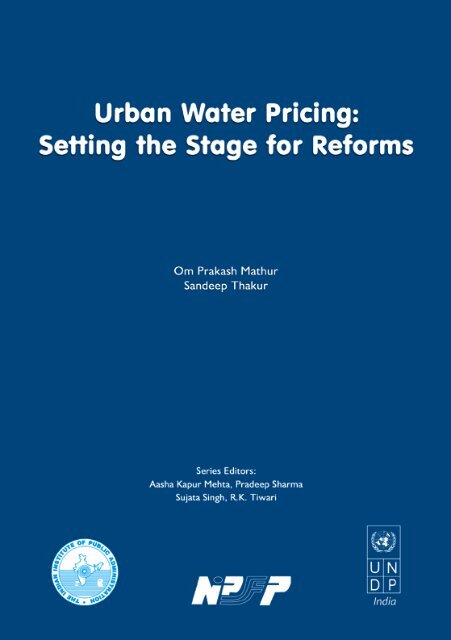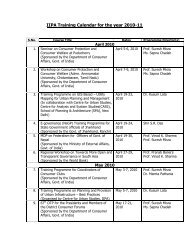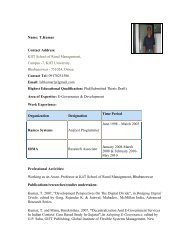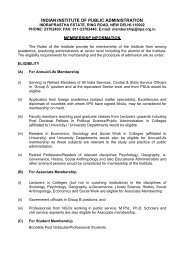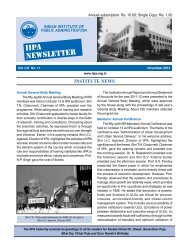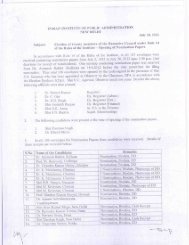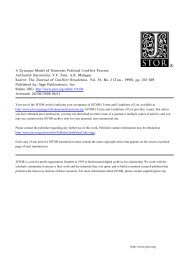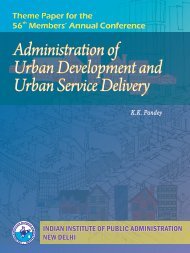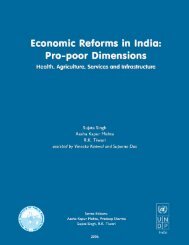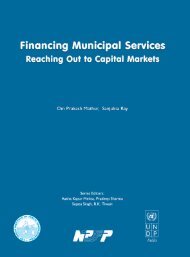Urban Water Pricing: Setting the Stage for Reforms. - Indian Institute ...
Urban Water Pricing: Setting the Stage for Reforms. - Indian Institute ...
Urban Water Pricing: Setting the Stage for Reforms. - Indian Institute ...
Create successful ePaper yourself
Turn your PDF publications into a flip-book with our unique Google optimized e-Paper software.
<strong>Urban</strong> <strong>Water</strong> <strong>Pricing</strong>:<strong>Setting</strong> <strong>the</strong> <strong>Stage</strong> <strong>for</strong> Re<strong>for</strong>msOm Prakash MathurSandeep ThakurSeries Editors:Aasha Kapur Mehta, Pradeep SharmaSujata Singh, R.K. Tiwari2006
Chhattisgarh Infrastructure ReportAcknowledgmentsThe substantive contributions to <strong>the</strong> paper made by Dr. Govinda Rao, NIPFP, Dr Dale Whittington, University ofCarolina, Dr. Albert Breton, University of Toronto, Dr Kim Cuenco, World Bank, and participants of a UN-ESCAPRegional Workshop on Pro-Poor and Sustainable <strong>Urban</strong> <strong>Water</strong> and Waste <strong>Water</strong> Management at Thailand are gratefullyacknowledged as is <strong>the</strong> support provided by Mr P.K. Deb, Joint Secretary, DEA, Mr. S.Banerjee, <strong>for</strong>mer Joint Secretary,DEA and Mr. Maurice Dewulf and Dr. Pradeep Sharma, UNDP. Ms Rekha word processed <strong>the</strong> paper at NIPFP.
Table of Contents1234The Importance of <strong>Urban</strong> <strong>Water</strong> <strong>Pricing</strong> 1<strong>Urban</strong> <strong>Water</strong> <strong>Pricing</strong>: Instruments and Methods 5<strong>Water</strong> <strong>Pricing</strong> Experiences: A Four-City Survey 10<strong>Water</strong> <strong>Pricing</strong>: <strong>Setting</strong> <strong>the</strong> <strong>Stage</strong> For Re<strong>for</strong>ms 17Annexure 22Glossary 24References 25
Chhattisgarh Infrastructure ReportList of Tables, Boxes and FiguresList of Tables1. <strong>Water</strong> Tax on Annual Rateable value: Brihanmumbai Mahanagarpalika-1999 52. Increasing Block Tariff <strong>for</strong> Domestic Use -1999 73. Uni<strong>for</strong>m <strong>Water</strong> Tariff 84. Linear <strong>Water</strong> Charge (Domestic), Kerala-1999 84(a). Linear <strong>Water</strong> Charge (Non- Domestic), Kerala-1999 85. Two-Part Tariff, Hyderabad 86. <strong>Pricing</strong> Structures of Unmetered Supplies 97. Institutional Set-Up <strong>for</strong> Operating <strong>Urban</strong> <strong>Water</strong> Systems, Illustrative-2000 108. Institutional Framework <strong>for</strong> <strong>Water</strong> Provision -2000 119. <strong>Water</strong> Provision in Sampled Cities-2000 1110. <strong>Water</strong> Connection Charge, Pune -2000 1311. <strong>Water</strong> Connection Charge, Bangalore-2000 1312. Annual <strong>Water</strong> Benefit Tax, Pune 1313. <strong>Water</strong> Charge <strong>for</strong> Metered Connections, Pune 1314. Annual <strong>Water</strong> Charge <strong>for</strong> Slum Settlements, Pune 1315. Volumetric Domestic <strong>Water</strong> Tariffs, Bangalore-2000 1316. <strong>Water</strong> Charges <strong>for</strong> Domestic Use in Agra and Allahabad (Rs.)-2000 1317. Structure of Cost Incurred on <strong>Water</strong> Provision, as a Percentage of Total Cost (1995/96) 1418. Structure of Cost Incurred on <strong>Water</strong> Provision, as a Percentage of Total Cost (1999/00) 1419. Per Unit/kl Structure of Cost in <strong>Water</strong> Provision (1999/00) 1520. <strong>Water</strong> Account Recoveries 1521. <strong>Water</strong> Price – Cost Linkage 1622. Relationship between <strong>Pricing</strong> Re<strong>for</strong>ms and Selected Country Characteristics 19
Boxes1. National <strong>Water</strong> Policy, 2002: An Excerpt 32. ADB’s <strong>Water</strong> <strong>Pricing</strong> Policy 43. <strong>Water</strong> Tariffs in Latin American Countries 94. What is capacity to pay <strong>for</strong> urban water? 16
<strong>Urban</strong> <strong>Water</strong> <strong>Pricing</strong>:<strong>Setting</strong> <strong>the</strong> <strong>Stage</strong> <strong>for</strong> Re<strong>for</strong>msOm Prakash Mathur, Sandeep Thakur *1The Importance of <strong>Urban</strong> <strong>Water</strong> <strong>Pricing</strong><strong>Setting</strong> appropriate prices is central to <strong>the</strong> re<strong>for</strong>m of <strong>the</strong>urban water sector in India. 1 Current levels of water pricingin most <strong>Indian</strong> cities and towns are deficient in severalrespects. Firstly, <strong>the</strong> price of urban water is low in relationto <strong>the</strong> cost incurred in its provision. Although firmestimates in respect of water price and costs are vague,on an average, prices or recoveries from <strong>the</strong> sale of waterand o<strong>the</strong>r charges relating to water provision are approximately22 to 25 per cent lower than <strong>the</strong> operation andmaintenance costs. Recent city-specific studies of Bangalore,Chennai and Hyderabad show that <strong>the</strong> typical pricecharged <strong>for</strong> water <strong>for</strong> residential use is about Rs.1.50 percubic meter which is one-tenth of <strong>the</strong> operating and maintenancecosts actually incurred (Raghupathi and Foster,2002), raising serious concerns about <strong>the</strong> financial viabilityand sustainability of urban water utilities (World Bank,1995). Annual losses on account of operating and maintainingurban water supply systems are conservatively estimatedat Rs. 50,000 to 60,000 million, placing an enormousburden on water supplying entities. Secondly, under-pricinghas resulted in poor service and reduced incentivesto expand <strong>the</strong> spatial coverage of services. Althoughmost cities and towns have been able to reach areasonably high level of access to safe water – 90.01 percentaccording to <strong>the</strong> Census of India, 2001, only about50 percent of <strong>the</strong> urban households have “tap water withinpremises”. Access to tap water within premises is as lowas 27.1 percent in Bihar, 29.3 percent in Kerala, and 34.9percent in Tamil Nadu. Most households face limitedhours of service and water services are uni<strong>for</strong>mly substandard.The cost of intermittent water supplies <strong>for</strong>households is said to be high; according to a recent paper,<strong>the</strong> average capital cost <strong>for</strong> installing pumps, waterfilters, tanks and o<strong>the</strong>r equipment is estimated at Rs. 2,620*The views expressed in this paper are those of <strong>the</strong> authors and do not necessarily reflect <strong>the</strong> views of GOI, UNDP, IIPA or <strong>the</strong> collaboratinginstitutions.1<strong>Water</strong> price re<strong>for</strong>m is an important agenda in many developing countries. See <strong>the</strong> following quote. “The re<strong>for</strong>mulation of tariffs and subsidypolicies is central to <strong>the</strong> re<strong>for</strong>m of water and sanitation services in developing countries. The traditional model of service provision has coupledpublic ownership with tariffs that are set well below <strong>the</strong> cost of <strong>the</strong> service, justifying this in terms of <strong>the</strong> importance of water services <strong>for</strong> <strong>the</strong> healthstatus of <strong>the</strong> poor. However, results have often been unsatisfactory. Service quality and coverage remain inadequate in many countries, and subsidiesdirected at public water companies have often benefited <strong>the</strong> middle classes ra<strong>the</strong>r than <strong>the</strong> poor, who remain unconnected to <strong>the</strong> public network.Re<strong>for</strong>mers have proposed to break out of this low level equilibrium through a combination of private sector1
<strong>Urban</strong> <strong>Water</strong> <strong>Pricing</strong>: <strong>Setting</strong> <strong>the</strong> <strong>Stage</strong> <strong>for</strong> Re<strong>for</strong>msper household (Rana, 2003). In Delhi, <strong>the</strong> annual cost ofreducing water supply unreliability is placed at Rs. 844per household (Zerah, 2000). The Government of Indiaand <strong>the</strong> World Bank recently reported that urban watersystems in India “deliver on average 50 to 60 percent of<strong>the</strong>ir capacity to end-users, compared with 80 to 85 percentin o<strong>the</strong>r countries. Poor, and sometimes non-existent,management leads to waste and inefficiency, with <strong>the</strong> resultantlarge claim on resources that could be redeployed<strong>for</strong> service improvements”. Tariff adjustments to achievecost recovery are central to <strong>the</strong> water sector. Most watersupplying entities in India operate at a loss. They finance<strong>the</strong> shortfall between tariff revenue and costs through operatingand capital subsidies from <strong>the</strong> government andthrough depreciation of capital. The result is a low levelequilibrium characterised by low tariff, poor service andlimits on access, especially of poor households.Thirdly, <strong>the</strong> objective of large-scale subsidisation of wateron grounds of lack of af<strong>for</strong>dability by <strong>the</strong> poor has notbeen achieved. Much of <strong>the</strong> evidence points out that <strong>the</strong>poor pay more, often two-to-three times, if coping costswere included, and <strong>the</strong> price subsidy meant <strong>for</strong> <strong>the</strong>m andbuilt into tariff structures, e.g., in increasing block tariff(IBT) is appropriated by <strong>the</strong> non-poor households. Subsidieson private taps are poorly targeted, as no more than30 percent of <strong>the</strong> beneficiaries are poor. Moreover, a largeproportion of urban poor households do not have privateconnections and are, <strong>the</strong>re<strong>for</strong>e, unable to benefit fromwater subsidies. Such regression in <strong>the</strong> distribution of subsidieswhere <strong>the</strong> poor do not have access to subsidisedpiped water service is a common phenomenon in <strong>Indian</strong>cities and towns. Fourthly, under-pricing has affected <strong>the</strong>finances of state governments who have ei<strong>the</strong>r absorbed<strong>the</strong> losses of urban water utilities or adjusted <strong>the</strong> losses byreducing <strong>the</strong> capital account support to <strong>the</strong>m <strong>for</strong> capacityexpansion. Although <strong>the</strong> macroeconomic consequencesof low water prices are difficult to assess, urban waterservices could cost <strong>the</strong> state governments <strong>the</strong> equivalentof 0.3 to 0.4 percent of <strong>the</strong>ir gross domestic product.When water tariffs are lower than <strong>the</strong> cost of provision,<strong>the</strong>re is little incentive to expand <strong>the</strong> service and fewer resourcesare allocated to water than would be optimal.<strong>Urban</strong> water services are important <strong>for</strong> economic growth,productivity and poverty reduction. The financial viabilityand sustainability of India’s water supplying entities has beenconsistently emphasised in water policies enunciated in successiveFive Year Plans. The Working Group set up to<strong>for</strong>mulate <strong>the</strong> Ninth Five Year Plan <strong>for</strong> urban water proposedadoption of <strong>the</strong> principle of full cost recovery inorder to enhance <strong>the</strong> financial viability of <strong>the</strong> water sectorand full autonomy <strong>for</strong> institutions responsible <strong>for</strong> watersupply in determining water tariff and tariff policy. Itproposed that subsidies <strong>for</strong> <strong>the</strong> poorer sections should beselective, well targeted, and transparent to ensure that <strong>the</strong>rewas no excessive cross-subsidisation from o<strong>the</strong>r sectorslike industry or commerce (Ministry of <strong>Urban</strong> Affairs andEmployment, 1996). Apart from laying emphasis on <strong>the</strong>financial aspects of urban water utilities and consideringthat urban water has important implications <strong>for</strong> productivityand quality of life, <strong>the</strong> Ninth Five Year Plan underlined<strong>the</strong> importance of universal coverage of <strong>the</strong> populationby water supply, adequacy in terms of water consumptionnorms, integration of water supply with liquidwaste management, recycling of waste water and sewageand privatisation and participation of <strong>the</strong> community in<strong>the</strong> management of water supply systems (Planning Commission,1997). In a recent paper titled, <strong>Urban</strong> <strong>Water</strong> Supplyand Sanitation, <strong>the</strong> World Bank has made similar observations,stating that setting of water tariffs must increasinglyfocus both on economic efficiency and financial viability,without losing sight of social af<strong>for</strong>dability (WorldBank, 1999). Tariff rationalisation, according to <strong>the</strong> paper,is an essential pre-requisite to <strong>the</strong> financial viability ofagencies responsible <strong>for</strong> water supply and <strong>for</strong> increasing<strong>the</strong> financial flows into <strong>the</strong> sector.The Tenth Five Year Plan (2002-2007) has rein<strong>for</strong>ced <strong>the</strong>water sector agenda as laid out in <strong>the</strong> Ninth Plan. While anassessment of issues relating to urban water supply is discussedelsewhere, it is important to reproduce <strong>the</strong> followingquote from <strong>the</strong> Tenth Plan that sums up <strong>the</strong> wateragenda: “<strong>the</strong> unfinished tasks in water supply in urban areasmay be summed up as augmentation to reach <strong>the</strong> prescribednorms, higher degree of reliability, assurance ofwater quality, a high standard of operation and manage-2
The Importance of <strong>Urban</strong> <strong>Water</strong> <strong>Pricing</strong>ment, accountability to customers and in particular specialarrangements to meet <strong>the</strong> needs of <strong>the</strong> urban poorand <strong>the</strong> levy and recovery of user charges to finance <strong>the</strong>maintenance functions as well as facilitate fur<strong>the</strong>r investmentin <strong>the</strong> sector. The achievement of <strong>the</strong>se tasks dependsto a large extent on <strong>the</strong> willingness of <strong>the</strong> stategovernments and ULBs (urban local bodies) to restructurewater supply organisations, levy reasonable waterrates, take up re<strong>for</strong>ms in billing, accounting and collection;and become creditworthy in order to have access tomarket funding” (Planning Commission 2002). It fur<strong>the</strong>robserves that <strong>the</strong> “re<strong>for</strong>ms (in <strong>the</strong> water sector) relate tomaking <strong>the</strong> sector more professionally managed, withadequate autonomy and financial powers, and levy ofuser charges preferably determined by an independent regulatoryauthority. By <strong>the</strong> end of <strong>the</strong> Tenth Plan, <strong>the</strong> targetwould be to recover full operations and maintenance coststhrough <strong>the</strong> levy of user charges” (ibid.). Financialsustainability has been emphasised in <strong>the</strong> Government ofIndia’s National <strong>Water</strong> Policy, as seen in <strong>the</strong> quote (Box 1).This study on ‘<strong>Urban</strong> <strong>Water</strong> <strong>Pricing</strong>: <strong>Setting</strong> <strong>the</strong> <strong>Stage</strong> <strong>for</strong>Re<strong>for</strong>ms’ is in response to <strong>the</strong> need to fur<strong>the</strong>r advance<strong>the</strong> above-stated agenda. The present position where <strong>the</strong>water supplying entities—be <strong>the</strong>se <strong>the</strong> parastatalorganisations or <strong>the</strong> municipal governments – run intolosses by selling water below cost and where <strong>the</strong>ir losseshave to be ei<strong>the</strong>r written off or adjusted against futuregrants or absorbed by <strong>the</strong> states or merely allowed to bekept on <strong>the</strong> books, is unsustainable. Under-pricing ofurban water, has not only affected <strong>the</strong> financial health ofwater supply undertakings, but also resulted in wastefulusage of water and as referred to earlier, impeded <strong>the</strong>expansion of water services and reduced <strong>the</strong> coverageof urban poor households.Although <strong>the</strong> need <strong>for</strong> getting <strong>the</strong> prices right appears obviousand compelling, what is, in fact, an appropriate chargeis nei<strong>the</strong>r straight<strong>for</strong>ward nor easy to determine. Literaturesuggests at least three sets of pricing mechanisms:i) long-run marginal cost,ii) short-run marginal cost, andiii) average costs.Box 1 National <strong>Water</strong> Policy, 2002: An ExcerptBesides creating additional water resources facilities<strong>for</strong> various uses, adequate emphasis needs to begiven to <strong>the</strong> physical and financial feasibility ofexisting facilities. There is, <strong>the</strong>re<strong>for</strong>e, a need to ensurethat <strong>the</strong> water charges <strong>for</strong> various users should befixed in such a way that <strong>the</strong>y cover at least <strong>the</strong>operation and maintenance charges of providing <strong>the</strong>service initially and a part of <strong>the</strong> capital costsubsequently. These rates should be linked directlyto <strong>the</strong> quality of service provided. The subsidy onwater rates to <strong>the</strong> disadvantaged and poorer sectionsof <strong>the</strong> society should be well targeted and transparent.Source: National <strong>Water</strong> Policy, 2002, The Government of IndiaWhile in <strong>the</strong>mselves <strong>the</strong>y are unassailable, <strong>the</strong>y do not helpa water supplying entity to determine an appropriate charge<strong>for</strong> water, which requires addressing a host of questions:what costs are incurred in water provision? What is <strong>the</strong>nature of <strong>the</strong>se costs? What are <strong>the</strong> different ways in whichcosts can be recovered? What instruments can be used?Who should pay <strong>for</strong> <strong>the</strong> lost water?The agenda of appropriate urban water pricing as enunciatedin successive Five Year Plans and o<strong>the</strong>r initiatives require that<strong>the</strong> following issues be specifically examined and analysed:i) Instruments of water charging: In what alternative waysis urban water charged and to what extent do <strong>the</strong>seinstruments meet <strong>the</strong> contemporary principles of watercharging?ii) Existing pricing structures: What pricing structures arecurrently in use? What objectives and principles underlie<strong>the</strong>m? What are <strong>the</strong>se based on?iii) Price-cost linkages: What part of <strong>the</strong> cost is recoveredby prices? What is <strong>the</strong> impact of non-revenue waterand implicit subsidies on cost recovery?These issues are examined in this paper, using <strong>the</strong> datadrawn from Bangalore, Vadodara, Allahabad and Agra,as also data from o<strong>the</strong>r ongoing studies on <strong>the</strong> financialstructures of municipalities and city-specificparastatal agencies responsible <strong>for</strong> water provision. Itlays out a framework <strong>for</strong> pricing re<strong>for</strong>ms in <strong>the</strong> watersector. It emphasises <strong>the</strong> need to ga<strong>the</strong>r in<strong>for</strong>mationabout <strong>the</strong> structure of supply costs and consumer preferences.By understanding <strong>the</strong> latter, it is expected that3
<strong>Urban</strong> <strong>Water</strong> <strong>Pricing</strong>: <strong>Setting</strong> <strong>the</strong> <strong>Stage</strong> <strong>for</strong> Re<strong>for</strong>msBox 2: ADB’s <strong>Water</strong> <strong>Pricing</strong> PolicyConservation of water and its sustainable use areincreasingly critical factors in managing a scarceresource. Governments and civil society need to seewater as an economic good. Financial incentives <strong>for</strong>optimising water use will be streng<strong>the</strong>ned through amix of water charges, market-based instruments andpenalties. Public awareness programs will rein<strong>for</strong>ce <strong>the</strong>incentives, which include water use rights, licenses andcharges, tradable permits, effluent charges, watertreatment fees, access fees, environmental liabilitiesand tax incentives. Managing water demand is afunction of efficient pricing, effective regulation andappropriate reduction and awareness. ADB will promotetariff re<strong>for</strong>ms through its water-related projects andprogrammes to modify structures and rates so that <strong>the</strong>yreward conservation and penalise waste.ADB will consistently advise governments of <strong>the</strong> needto adopt cost recovery principles in <strong>the</strong>ir water policiesand strategies. The expansion of access to water and<strong>the</strong> improved provision of water services require thatcapital costs be funded mainly from within <strong>the</strong> sectorby accessing <strong>the</strong> debt market and developingappropriate tariff structures. Consumers will be expectedto meet <strong>the</strong> full operation and maintenance costs ofwater facilities and service provision in urban and ruralwater supply and sanitation schemes subject to subsidyconsiderations. ADB will also promote <strong>the</strong> inclusion ofenvironmental externalities and <strong>the</strong> recovery ofresources management cost in Tariff systems adoptedby DMCs.Subsidies are a controversial issue in <strong>the</strong> water sector.ADB will support subsidies <strong>for</strong> water services in <strong>the</strong>following circumstances: (i) where treated water useshave beneficial external effects in preventing healthproblems, (ii) where <strong>the</strong> transaction costs of measuringusage are very high and (iii) where a limited quantityof treated water <strong>for</strong> <strong>the</strong> poor is regarded as a basichuman need.Source: <strong>Water</strong> <strong>for</strong> All, The <strong>Water</strong> Policy of <strong>the</strong> Asian Development Bank, 2001water utility companies will be able to offer price and serviceoptions to consumers that are more efficient than <strong>the</strong>existing system.Section 2 presents <strong>the</strong> key instruments of urban water chargingand water pricing structures. Section 3 analyses <strong>the</strong>experiences with urban water pricing in four cities andsupplements this with o<strong>the</strong>r examples. This section examines<strong>the</strong> structure of costs in supplying water and <strong>the</strong> differentwater charging instruments and <strong>the</strong> outcomes in termsof revenues and expenditures, in particular. Section 4 providesa framework <strong>for</strong> urban water charging toge<strong>the</strong>r witha brief explanation of objectives that water pricing mustaim to achieve.4
Natural Resource2<strong>Urban</strong> <strong>Water</strong> <strong>Pricing</strong>: Instruments andMethodsInstruments of <strong>Urban</strong> <strong>Water</strong>ChargingThree types of instruments are generally used when charging<strong>for</strong> water. The first is a connection fee or a fixed accesscharge. Such a fee is levied to provide <strong>the</strong> user with aconnection to a municipal (public) water supply system. Aconnection fee or charge is based on <strong>the</strong> size of <strong>the</strong> plot orholding or <strong>the</strong> size of <strong>the</strong> connection and ferrule or a combinationof plot size and <strong>the</strong> size of <strong>the</strong> ferrule. It is unclearif <strong>the</strong> connection fee is designed to contain an elementof <strong>the</strong> capital cost that is involved in laying out <strong>the</strong>distribution network.The second is a water tax, <strong>for</strong> which provision exists inmost municipal legislations. It is a tax which is unrelated towater use or consumption. It <strong>for</strong>ms a part of propertytaxation and is leviable on <strong>the</strong> annual rateable value of landand property and is meant to essentially serve as a generaltax. Conditions under which a water tax may be levied areprescribed in municipal legislations, which, among o<strong>the</strong>rs,include categories of water users who may be exemptedfrom <strong>the</strong> payment of water taxes, a ceiling on <strong>the</strong> rate atwhich water tax may be levied and <strong>the</strong> use to whichreceipts from such a levy may be applied. For example,<strong>the</strong> Uttar Pradesh Municipalities Act laysdown that a water tax may not be levied on propertieswhich have an annual value of less than Rs.300; <strong>the</strong> Uttar Pradesh Municipal Corporation Act,1959 lays down that <strong>the</strong> proceeds of water tax (and drainageand conservancy taxes) may be pooled and used <strong>for</strong>purposes connected with <strong>the</strong> construction, maintenance,extension and improvement of <strong>the</strong> service. TheMaharashtra Municipal Act 1965 provides <strong>for</strong> a generalwater tax as a part of <strong>the</strong> consolidated tax on propertyand a special water tax <strong>for</strong> water supplied by <strong>the</strong> municipalcouncil. It fur<strong>the</strong>r lays down that a municipal council,instead of imposing a special water tax, may fix rates <strong>for</strong><strong>the</strong> supply of water by measurement. The Bombay MunicipalCorporation Act provides <strong>for</strong> a water tax if <strong>the</strong>premises are not charged <strong>for</strong> water by measurement; anda water benefit tax, which is in addition to water tax orwater charges on all residential properties in GreaterBombay. <strong>Water</strong> tax and water benefit tax are applied to<strong>the</strong> annual rateable value of premises, with <strong>the</strong> tax ratedifferentiating between residential and non-residential properties(Table 1).A third method of charging is a water charge. Conceptuallydesigned as a charge on consumption, it is a ubiquitousinstrument <strong>for</strong> charging both metered and unmetered watersupplies. Besides a connection fee, a water tax and a waterTable 1: <strong>Water</strong> Tax on Annual Rateable Value:Brihanmumbai Mahanagarpalika - 1999Nature of premises <strong>Water</strong> tax rate (%) <strong>Water</strong> benefit (%)Residential 20 10Non-residential 45 20Source: Government of Maharashtra5
<strong>Urban</strong> <strong>Water</strong> <strong>Pricing</strong>: <strong>Setting</strong> <strong>the</strong> <strong>Stage</strong> <strong>for</strong> Re<strong>for</strong>mscharge, <strong>the</strong>re are minor instruments such as a meter rent, alicense fee, a water cess, a meter maintenance charge wheremeters are provided by <strong>the</strong> water supplying agency, developmentcharges, 2 and fixed charges <strong>for</strong> <strong>the</strong> capital renovation3 of <strong>the</strong> water system, which are used <strong>for</strong> operatingwater supply systems. Many of <strong>the</strong> instruments yield littlerevenue, raising questions about <strong>the</strong> purpose <strong>for</strong> which <strong>the</strong>yare being kept on statutes or rules.<strong>Water</strong> <strong>Pricing</strong> StructuresMarginal cost pricing is an indispensable aspect of waterpricing rules (American <strong>Water</strong> Works Association, 1991).A basic premise <strong>for</strong> <strong>the</strong> creation of autonomous waterboards, <strong>for</strong> instance, was that <strong>the</strong>y will be able to set tariffequal to <strong>the</strong> marginal cost of providing services to eachcategory of consumers. However, few water-supplyingentities have control over price fixation. Fur<strong>the</strong>r, implementing<strong>the</strong> principle of marginal cost pricing <strong>for</strong> waterhas proved to be difficult on account of <strong>the</strong> problems inusing historical accounting data, estimating external costs,apportioning joint costs and addressing equity-related concerns.These problems have impeded <strong>the</strong> use of marginalcost pricing by water agencies. The American <strong>Water</strong> WorksAssociation contends in this regard that, “<strong>the</strong> applicationof <strong>the</strong> <strong>the</strong>ory of marginal cost pricing to water rates lackconsiderable practicality”. Prices are efficient if <strong>the</strong>y areset equal to <strong>the</strong> long-run marginal cost of water provision.<strong>Water</strong> pricing structures in India are extremely complexand often clumsy. At one level, price structures distinguishbetween metered connections and unmetered connectionsas also bulk provision and non-bulk, discrete provision.At ano<strong>the</strong>r level, price discrimination is common with (i)categories of water users, which comprise not only <strong>the</strong>principal categories of domestic users and non-domesticusers, but also <strong>the</strong> assorted categories consisting of wateruse <strong>for</strong> washing motor vehicles, cattle sheds, stables and<strong>the</strong> like and (ii) income groups of households, <strong>the</strong> assumptionbeing that low-income households use lower quantitiesof water and high-income households have higherconsumption levels. <strong>Water</strong> pricing may differ with <strong>the</strong>quality of water supply, e.g., filtered, unfiltered, tube-wellsupplies, etc. Cross-subsidy is central to <strong>the</strong> principle ofprice discrimination. As will be seen later, non-domesticusers subsidise <strong>the</strong> domestic sector. High-income householdsusing larger quantities of water subsidise low-incomehouseholds, raising questions about <strong>the</strong> desirability of overloadingcertain categories of water users.<strong>Water</strong> pricing structures are ei<strong>the</strong>r volumetric or non-volumetric.Volumetric structures rely in one way or ano<strong>the</strong>ron <strong>the</strong> volume (quantity) of water and are used only underconditions of metered supplies of water. Non-volumetricstructures are applied to o<strong>the</strong>r measures that are proxiesto water consumption.A tariff structure is a set of procedural rules that determine<strong>the</strong> service conditions and charges <strong>for</strong> various categoriesof water users. As stated earlier, charges <strong>for</strong> waterare based on two components: <strong>the</strong> volume of water consumedand a set of factors o<strong>the</strong>r than water use. Conceptually,it is possible to use one of <strong>the</strong> two components:thus, water can be charged on <strong>the</strong> basis of <strong>the</strong> value ofproperty (water tax) ra<strong>the</strong>r than on <strong>the</strong> level of consumption.Alternatively, water can be charged on <strong>the</strong> basis ofwater use multiplied by <strong>the</strong> unit price. A variant, whichis more common, is to use a mix of <strong>the</strong> two, i.e., afixed monthly charge and a charge based on consumption.Several types of water tariff are in use in <strong>Indian</strong> citiesand towns. Increasing block tariff (IBT): An increasing blocktariff is a series of prices that increase in steps as consumptionrises. The key feature of IBT is that it contributesto equity by allowing low-income households to paylower rates <strong>for</strong> water than o<strong>the</strong>r households. An IBT structureis based on <strong>the</strong> volumetric component. A water userin a particular category, such as residential, is charged arelatively low price per unit <strong>for</strong> consumption up to a specificamount. This amount defines <strong>the</strong> size of <strong>the</strong> initialblock. A user whose consumption exceeds <strong>the</strong> size of <strong>the</strong>2Development charges are meant to cover <strong>the</strong> cost of water and sewer lines, and are payable by plot holders. See <strong>the</strong> Schedule of Rates of <strong>the</strong> DelhiJal Board.3Fixed charges <strong>for</strong> capital valuation are a feature of <strong>the</strong> water charging system in Rajasthan. See <strong>the</strong> Notification of <strong>the</strong> Public Health EngineeringDepartment, dated 28 th May 1998.6
<strong>Urban</strong> <strong>Water</strong> <strong>Pricing</strong>: Instruments and Methodsinitial block faces a higher price per unit<strong>for</strong> <strong>the</strong> additional consumption until he exhausts<strong>the</strong> second block and <strong>the</strong>n a still higherprice until he reaches <strong>the</strong> top block in <strong>the</strong>increasing block structure. 4To construct an increasing block tariff, threeparameters are needed: (i) <strong>the</strong> number ofblocks, (ii) size of <strong>the</strong> block in terms of waterand (iii) <strong>the</strong> price per unit in each block.The case <strong>for</strong> IBT is argued on several grounds.First, IBT provides equity, as high-income households tendto subsidise <strong>the</strong> water usage of low-income households.Consumption levels of water among high income householdsis greater and because a greater percentage of <strong>the</strong>irwater use occurs in <strong>the</strong> higher blocks, <strong>the</strong>y pay a higher averageprice <strong>for</strong> water. Second, IBT can promote water conservationand sustainable water use. This is because <strong>the</strong> pricein <strong>the</strong> higher blocks is at high rates and discourages wastefulwater use. Third, an IBT is needed to implement marginalcost principles. It is argued in this regard that because marginalcosts are expected to rise with total water use, pricesshould rise accordingly with individual household use. Thishas been <strong>the</strong> main justification <strong>for</strong> multi-block structures.Thus, <strong>for</strong> an increasing and decreasing block tariff structure,a water bill could be calculated as under:LetQ* = amount of water sold to a specific consumer.Q 1= maximum amount of water that can be sold in<strong>the</strong> first block at price P 1Q 2= maximum amount of water that can be sold in<strong>the</strong> second block at P 2Q 3= maximum amount of water that can be sold in<strong>the</strong> third block at P 3If Q*
<strong>Urban</strong> <strong>Water</strong> <strong>Pricing</strong>: <strong>Setting</strong> <strong>the</strong> <strong>Stage</strong> <strong>for</strong> Re<strong>for</strong>msTable 3: Uni<strong>for</strong>m <strong>Water</strong> TariffCity Uni<strong>for</strong>m (Rs./kl) tariffDomestic IndustryKanpur 2.0 10.0Indore 2.0 22.0Surat 2.0 8.0Madurai 5.0 20.0Source: NIPFP, Field WorkTable 4: Linear <strong>Water</strong> Charge(Domestic), Kerala-1999Connection/kl Charge includingmeter inspectioncharge (Rs.)10 2211 2512 2813 3125 6750 182100 550Source: NIPFP, Field WorkTable 4(a): Linear <strong>Water</strong> Charge(Non- Domestic), Kerala-1999Connection/kl Charge includingmeter inspectioncharge (Rs.)10 10214 10516 12020 14925 18750 370100 900Source: NIPFP, Field WorkTable 5: Two-Part Tariff,HyderabadPart Rs.Part 1Minimum/month 55.0Part 2500 kl 14.00//klSource: NIPFP, Field Workuni<strong>for</strong>m tariff is commonly used in such cities as Kanpur, Indore, Surat andMadurai (Table 3). The main merit of uni<strong>for</strong>m tariff lies in its simplicity. At <strong>the</strong>same time, it provides no incentive to consumers to effect savings on water useand may in fact, violate <strong>the</strong> principle of water conservation.Linear watercharge: This is a charge, which rises with consumption, notin blocks, as is <strong>the</strong> case with IBTs, but with every discrete unit of waterconsumption. Tables 4 and 4a illustrate this <strong>for</strong> Kerala. Thus, a consumerin Kerala is required to pay a monthly charge of Rs. 22 <strong>for</strong> consumptionnot exceeding 10 kl, <strong>the</strong> charge increases to Rs. 25 <strong>for</strong> a connection levelof 11 kl, and rises in tandem, until it reaches 100 kl <strong>for</strong> which <strong>the</strong> chargeis Rs. 550.Two-parttariff: A two-part tariff with a minimum charge <strong>for</strong> a fixedquantity of water beyond which <strong>the</strong> charge may ei<strong>the</strong>r follow an IBTstructure or a uni<strong>for</strong>m tariff. Conceptually, a minimum charge is in <strong>the</strong>nature of a rent payable by all users having a water connection, whe<strong>the</strong>ror not water is used (Table 5). The minimum charges are so fixed that<strong>the</strong>y are lower than <strong>the</strong> tariff rate laid down <strong>for</strong> <strong>the</strong> initial block, giving<strong>the</strong> advantage of a lower tariff to low water consuming households (SeeBox in Annexure).Tariff <strong>for</strong> unmetered supplies: Price structures commonly used <strong>for</strong>unmetered supplies are ei<strong>the</strong>r annual fixed charges as shown in Table 6,or charges that vary with <strong>the</strong> size of <strong>the</strong> water connection. Separatepricing structures are applied to standpoint connections where such chargesare provided <strong>for</strong> under <strong>the</strong> rules.The above example demonstrates <strong>the</strong> complex nature of water pricestructures in <strong>Indian</strong> cities and towns. Variations are far too large to be ableto test <strong>the</strong>ir adequacy with respect to <strong>the</strong> objectives that underlie designingpricing systems and structures. Most pricing systems, particularly thosewhere water is a municipal responsibility, are historically driven with littlechange having been effected in <strong>the</strong>ir <strong>for</strong>mat and structure. A typical exampleis of <strong>the</strong> Kolkata Municipal Corporation where users have beendivided into 49 categories <strong>for</strong> <strong>the</strong> levy of a connection fee. These categoriescomprise, among o<strong>the</strong>rs, stables, cooling plants, flushing purposes in<strong>the</strong> market areas, fire fighting, medical practitioners, film actors and painters,owners of newspapers, estate agents, race horse jockey, persons engagedin <strong>the</strong> profession of loading and unloading and o<strong>the</strong>rs. In recentyears, attempts have been made to simplify <strong>the</strong> pricing structures and toperiodically adjust <strong>the</strong>m in line with costs. In Bangalore, tariffs have beenrevised six times between 1999-2000; <strong>the</strong> Bangalore <strong>Water</strong> Supply andSewerage Board is endowed with powers to adjust <strong>the</strong> tariff if it is warrantedon account of an increase in power tariff rates; <strong>for</strong> <strong>the</strong> adjustment8
<strong>Urban</strong> <strong>Water</strong> <strong>Pricing</strong>: Instruments and Methodsof tariff on account ofo<strong>the</strong>r factors like salary increaseor additional maintenancecosts, <strong>the</strong>government’s approval isessential. The Chennai Metropolitan<strong>Water</strong> Supply andSewerage Board has alsotaken steps to simplify <strong>the</strong>tariff system. Many progressivemunicipal corporations,like Mumbai, havealso adjusted <strong>the</strong> tariffstructure in order to meet<strong>the</strong> rising cost of water provision,although it retains<strong>the</strong> historically complexpricing regime.Table 6: <strong>Pricing</strong> Structures of Unmetered SuppliesCity Annual flat rate (Rs./year) Annual ferrule based pricesDomestic Industrial Ferrule size Domestic Non-domestic/industrialVijayawada 480 -Surat - - ½” 1201” 6481½” 1,296Belgaum - - 1” 1,155 10,375Gwalior 720 1,440Nagpur ½” 300 1,200¾” 600 2,400Patiala 20** 60*Kanpur*** ½” 360-1200Gorakhpur ¾” 540-1800Note: Town in Punjab ££ 50-100* Per tap.** For <strong>the</strong> first tap; <strong>for</strong> <strong>the</strong> second and subsequent taps <strong>the</strong> rate declines.*** In Kanpur, <strong>the</strong> annual tariff depends on (a) ferrule and (b) annual rateable value.Source: NIPFP, Field WorkBox 3: <strong>Water</strong> Tariffs in Latin American Countries• There was a fixed minimum volume, which is charged<strong>for</strong> regardless of whe<strong>the</strong>r it is consumed. This is 15m 3 in most places; in Panama it is 30 m 3 <strong>for</strong> residentialconsumers and lower amounts <strong>for</strong> low-income areas.• The marginal per-meter charge <strong>for</strong> consumption above<strong>the</strong> minimum is a progressive function of <strong>the</strong> total volumeconsumed. In El Salvador <strong>the</strong>re were three ranges; inNicaragua <strong>the</strong>re were nine; in Panama five, and inVenezuela four. The degree of progressiveness relatedto volume varies considerably from place to place.• There are regional variations, which aim to capturedifferences in costs and/or in social conditions. Thesenormally specify a higher tariff <strong>for</strong> <strong>the</strong> metropolitansystem. In Venezuela <strong>the</strong>re were seven “types” oftariff; in El Salvador <strong>the</strong>re were two (metropolitan ando<strong>the</strong>r); in Nicaragua <strong>the</strong>re were two geographicaldistinctions within <strong>the</strong> capital city according to <strong>the</strong>distance from an historically important source and<strong>the</strong> regions paid less than <strong>the</strong> capital; in Panama<strong>the</strong>re were four regional or spatial variants in <strong>the</strong>tariff.• There was normally a special tariff <strong>for</strong> “social” cases.Sometimes this only applies to standpipes (ElSalvador); in o<strong>the</strong>r cases it applies generally toin<strong>for</strong>mal settlements (Managua, Panama,Venezuela).• In all <strong>the</strong>se systems, <strong>the</strong> coverage of micrometering is relatively low; in some of <strong>the</strong>m, it issimply non-existent. In such conditions, <strong>the</strong> watercompany’s discretionary estimates of each user’swater consumption are crucial to tariff setting. Thisdiscretion is often used with <strong>the</strong> intention of trimming<strong>the</strong> bill to what <strong>the</strong> company thinks each part of<strong>the</strong> market will bear.Source: Ian Walker, ibid9
<strong>Urban</strong> <strong>Water</strong> <strong>Pricing</strong>: <strong>Setting</strong> <strong>the</strong> <strong>Stage</strong> <strong>for</strong> Re<strong>for</strong>ms3<strong>Water</strong> <strong>Pricing</strong> Experiences:A Four-City SurveyveyInstitution Example Spatial JurisdictionPublic Health Rajasthan, Punjab, State-wideEngineeringHaryanaDepartment (PHED)State-level Kerala, Delhi State-wide UTparastatal agency (excluding NDMC)Metropolitan agency Bangalore, Chennai, Metropolitan-wideHyderabadCity-level Uttar Pradesh Lucknow, Varanasi, etcspecialized agencies Jal Sansthans.Municipal Corporations Gujarat, Maharashtra Mumbai, Ahmedabad, etc.10Table 7: Institutional Set-Up <strong>for</strong> Operating <strong>Urban</strong> <strong>Water</strong> Systems,Illustrative - 2000Municipalities (small)Source: NIPFP, Field workAndhra Pradesh,Uttar Pradesh, Tamil Nadu<strong>Urban</strong> water in India is a state subject; <strong>the</strong> centralgovernment’s responsibility in respect of water is definedin <strong>the</strong> River Board Act, 1956 and Inter-State <strong>Water</strong> DisputesAct, 1956 and is limited to <strong>the</strong> regulation and developmentof inter-state rivers and river basins and <strong>the</strong> provisionof support <strong>for</strong> programmes such as <strong>the</strong> acceleratedurban water supply, low cost sanitation and establishmentof water monitoring systems. The functions in respect ofthis sector stand allocated to <strong>the</strong> Public Health EngineeringDepartment (PHED), e.g., in Rajasthan; a state-level agencywith state-wide jurisdiction like <strong>the</strong> Kerala <strong>Water</strong> Authorityand Delhi Jal Board; state-level parastatals such as those inKarnataka and Uttar Pradesh (Karnataka <strong>Water</strong> Supply andSewerage Board and Uttar Pradesh Jal Nigam), metropolitan-levelagencies like in Bangalore, Chennai and Hyderabadand municipal corporations and municipalities in such statesas Gujarat, Madhya Pradesh and Maharashtra. It is not uncommonto find <strong>the</strong> existence of arrangements wherein capitalworks are dealt with by a state-level agency (PHED), and<strong>the</strong> operation and maintenance of water supply systems conductedby a city-level agency or municipality (Table 7).Participation of <strong>the</strong> <strong>for</strong>mal private sector (excluding <strong>the</strong> productionof bottled water) in urban water provision and managementis negligible, although several cities in India have witnessed<strong>the</strong> emergence of small-scale water providers. Smallscaleproviders are engaged in providing water to slum andsquatter settlements that are not served by public supplies.The sample cities namely Agra,Allahabad, Bangalore, Pune,and Vadodara display <strong>the</strong> samediverse arrangements; <strong>the</strong> municipalcorporations are responsible<strong>for</strong> <strong>the</strong> provision of waterin Pune and Vadodara, while<strong>the</strong> Uttar Pradesh Jal Sansthandischarges this function in Agraand Allahabad. A <strong>Water</strong> Supplyand Sewerage Board providesand maintains <strong>the</strong> watersupply system in Bangalore andis responsible <strong>for</strong> <strong>the</strong> capitalexpansion of <strong>the</strong> system.
<strong>Water</strong> <strong>Pricing</strong> Experiences: A Four-City Survey<strong>Water</strong> provision comprises (i) capital improvement work andasset creation, (ii) operations and maintenance and (iii) billing,levy and collection of water charges. Capital improvementworks include source development, installation of plants andpumping stations and laying of distribution networks and <strong>the</strong>like. Operations and maintenance functions relate to runningand maintaining <strong>the</strong> system and ensuring proper distributionof water. Minor capital works include repairs to <strong>the</strong> system,which also <strong>for</strong>m a part of <strong>the</strong> operations and maintenanceexpenditure. Levy and collection of charges <strong>for</strong> providingaccess to, and selling, water constitute an important responsibilityof water supplying entities.Pune and Vadodara Municipal Corporations and <strong>the</strong> Bangalore<strong>Water</strong> Supply and Sewerage Board hold responsibility<strong>for</strong> all functions relating to <strong>the</strong> provision of water.On <strong>the</strong> o<strong>the</strong>r hand, <strong>the</strong> Agra and Allahabad Jal Sansthansare responsible <strong>for</strong> <strong>the</strong> operations and billing and collectionof charges, while <strong>the</strong> responsibility <strong>for</strong> capital worksrests with <strong>the</strong> Uttar Pradesh Jal Nigam (Table 8).<strong>Water</strong> Provision: Key FeaturesThe sources of water supply to <strong>the</strong> sample cities compriserivers in <strong>the</strong> case of Agra and Allahabad which draw waterfrom <strong>the</strong> river Yamuna. Allahabad also draws waterfrom nearly 130 tube wells, dams, and bore wells. Agraand Allahabad do not have any assessment of water demand;demand is assumed to be co-terminus with <strong>the</strong> quantityof water that is released from <strong>the</strong> system. The Bangalore<strong>Water</strong> Supply and Sewerage Board (BWSSB) is ableto supply around 90 percent of <strong>the</strong> water demand andVadodara Municipal Corporation is also reported to bemeeting 98 percent of <strong>the</strong> city’s water requirements. Bangaloreis supplied with water from<strong>the</strong> Cauvery river, Arkavatty-T.G.Halli and Hessaraghatta rivers witha capacity of 540 million litres perday (mld), 140 mld and 25 mld respectively.Pune also has threesources namely, Khadkwasaladam, Pavana dam, and Pashan lakeAgraAllahabadBangaloreTable 8: Institutional Framework <strong>for</strong><strong>Water</strong> Provision - 2000PuneVadodaraSource: City-level SurveyUttar Pradesh Jal Sansthan/Jal NigamUttar Pradesh Jal Sansthan/Jal NigamBangalore <strong>Water</strong> Supply andSewerage BoardPune Municipal CorporationVadodara Municipal Corporationeach with a capacity of 160 mgd, 5 mgd, and 5 mgd respectively.The absence of data on effective water demandand its sensitivity to price change remains an importanthandicap in <strong>for</strong>mulating an appropriate water pricing policy.O<strong>the</strong>r aspects of water supply relate to <strong>the</strong> installed capacity,water released, volume of water charged and distributionlosses. It is common to observe differences betweenwater released and installed capacity (few cities wouldrelease <strong>the</strong> entire volume of water held in <strong>the</strong> system) on<strong>the</strong> one hand and between water charged and water released,on <strong>the</strong> o<strong>the</strong>r hand, <strong>the</strong> <strong>for</strong>mer usually being lessthan <strong>the</strong> water released on account of firstly, free waterthat many cities provide and secondly, distributional losses.In recent years, <strong>the</strong> quantity of non-revenue water has risenenormously. 6 Key statistics in respect to <strong>the</strong>se features aregiven in Table 9.The survey results show that <strong>the</strong> distributional losses are,on average, 30 percent, which are roughly twice <strong>the</strong> normsand standards. Free water supplied via public standpostsaccounts <strong>for</strong> 15 percent in Agra and 28 percent in Allahabad,whereas in Bangalore, <strong>the</strong> city corporation buys water from<strong>the</strong> Bangalore <strong>Water</strong> Supply and Sewerage Board (BWSSB)Table 9: <strong>Water</strong> Provision in Sampled Cities - 2000Features Agra Allahabad Bangalore PuneInstalled capacity (mld) 280 230 705 790<strong>Water</strong> released (mld) 250(89%) 210(91%) 645(91%) NADistributional losses (mld) 75(30%) 63(30%) 213(33%) 176(22%)Free water (mld) 37.5(15%) 58.8(28%) NA NA<strong>Water</strong> charged 137.5(55%) 117.6(56%) 432(67%) 517(65%)Source: City-level survey6Non-revenue water comprises free water, distributional losses and unaccounted <strong>for</strong> water, a euphemism <strong>for</strong> water that is drawn illegally.CityInstitution11
<strong>Urban</strong> <strong>Water</strong> <strong>Pricing</strong>: <strong>Setting</strong> <strong>the</strong> <strong>Stage</strong> <strong>for</strong> Re<strong>for</strong>ms<strong>for</strong> free distribution among urban poor communities. Thewater charge ranges from a low of 55 percent in Agra and56 percent in Allahabad to a high of 65 percent in Bangaloreand 67 percent in Pune. These facts, as we show later,have an important bearing on <strong>the</strong> financial viability of watersupplying entities.Metered versus unmetered water supplies are ano<strong>the</strong>r importantaspect that have an impact on <strong>the</strong> pricing structuresand consequently upon <strong>the</strong> overall financial health of watersupplying organisations. In Agra, of <strong>the</strong> 110,000 connections,80 percent are reported to be non-functional with <strong>the</strong>result that water billing is done on <strong>the</strong> basis of a minimumannual charge. This is a peculiar characteristic of domesticmeters; non-domestic meters are reported to be functionalwhere it has been possible to bill on <strong>the</strong> basis of water consumed.7 However, in view of <strong>the</strong> fact that domestic suppliesaccount <strong>for</strong> 80 percent of <strong>the</strong> total water consumptionin Agra, which carries a fixed annual charge, stagnation isobserved in <strong>the</strong> revenues earned from water sales.The position in Allahabad is similar to that in Agra: of <strong>the</strong>86,000 water connections only about 55 percent are metered,and of <strong>the</strong>se, 90 percent of <strong>the</strong> metered connectionsare not in working condition. In o<strong>the</strong>r words, five tosix percent of <strong>the</strong> households in Allahabad have workingmetered connections and pay according to <strong>the</strong> tariff fixed<strong>for</strong> <strong>the</strong>m. In Pune, properties connected to metered connectionsaccount <strong>for</strong> 41 percent of <strong>the</strong> total number ofproperties and properties with unmetered connections account<strong>for</strong> 27.7 percent. A noteworthy feature of <strong>the</strong> PuneMunicipal Corporation lies in water connections amongslum households.Charging InstrumentsAs indicated earlier, <strong>the</strong>re are different ways in which wateris charged <strong>for</strong>. In Agra and Allahabad, five instrumentsare used <strong>for</strong> charging water: a water tax using <strong>the</strong> annualrateable value (ARV) as <strong>the</strong> base; water charge on all meteredand unmetered water connections; meter rent onmetered water connections; development charge/fee <strong>for</strong>connections, which is akin to a connection charge; and serviceand supervision charges on all connections. Standpostsare not charged <strong>for</strong> in Agra and Allahabad. An importantfeature of <strong>the</strong> charging system in Agra and Allahabad isthat <strong>the</strong> charges discriminate between different categoriesof consumers: thus, <strong>the</strong> charges vary between domesticconsumers and non-domestic consumers, with non-domesticconsumers being fur<strong>the</strong>r categorised into specialindustry categories (Rs. 15/kl), business (Rs. 7.5/kl), governmentand semi-government institutions (Rs. 6.0/kl),Army Cantonment Board (Rs. 4.5 kl), and municipal works(Rs. 3.0/kl). 8 The charge <strong>for</strong> special industry is five timesthat of water <strong>for</strong> domestic users. Rate structures are givenin Tables 10 to 16. <strong>Pricing</strong> policies usually do not distinguishbetween access and usage. Subsidies are generally on<strong>the</strong> price of water, but <strong>the</strong> access charge (at least in somecities) tends to be high as this is linked to possession ofbuilt-up space. As a result, <strong>the</strong> subsidies are perverse andanti-poor.The BWSSB charges a connection fee, which is higher <strong>for</strong>upper floors in comparison with <strong>the</strong> ground floor and alsowhere <strong>the</strong> domestic users pay a lower fee as compared with<strong>the</strong> non-domestic users. Domestic consumers in high-rise apartmentbuildings and government institutions are charged atbulk rates and o<strong>the</strong>rs according to rates <strong>for</strong> different slabsand meter hire charges. In Pune, where water provision is <strong>the</strong>responsibility of <strong>the</strong> Pune Municipal Corporation, water charginginstruments comprise a water connection charge, a watertax, a water benefit tax, volumetric water charge and fixedcharges <strong>for</strong> new unmetered connections in slum settlements.Thus, water is charged <strong>for</strong> in different ways, consisting of (i) aone-time charge, invariably <strong>for</strong> a connection, (ii) an annualcharge or a tax, often leviable on <strong>the</strong> annual rateable value(ARV), and also a meter rent, generally leviable once a year;and (iii) a water consumption charge collected on a monthly,bi-monthly or an annual basis. A water charge from anunmetered household is more in <strong>the</strong> nature of a fee, ra<strong>the</strong>rthan a charge and promotes inefficient consumer behaviour.7It appears that <strong>the</strong> low tariff is a disincentive to keeping <strong>the</strong> meters in working condition. The government requires that water be supplied evenwhen meters are not in working condition.8Figures in paren<strong>the</strong>sis are <strong>the</strong> per kl charge <strong>for</strong> each category in Agra.12
<strong>Water</strong> <strong>Pricing</strong> Experiences: A Four-City SurveyTable 10: <strong>Water</strong> Connection Charge,Pune - 2000Diameter of <strong>the</strong> pipe Charges (Rs.)(in inches)0.50 5000.75 1,0001.00 2,5001-2.00 5,0002-3.00 7,5003-4.00 10,000Source: City-level surveyTable 11: <strong>Water</strong> Connection Charge,Bangalore - 2000TypeFee (Rs.)Domestic (ground floor) Rs. 1,620Domestic (ground and first floors) Rs. 2,220Domestic (ground and two floors) Rs. 2,820 + pro ratacharges @Rs.70/sq.meterNon-domesticRs. 1,050 + pro ratacharges@Rs.120/sq.meterSource: City-level surveyTable 12: Annual <strong>Water</strong> Benefit Tax,Pune (Rs.)Basic 1997 2000Annual rateable value 2% 2%Source: City-level surveyTable 13: <strong>Water</strong> Charge <strong>for</strong> MeteredConnections, PuneType 1997 2000Domestic 2.00 2.50Non-domestic 10.00 16.00Source: City-level surveyTable 14: Annual <strong>Water</strong> Charge<strong>for</strong> Slum Settlements, PuneYearRs.1997 175.02000 250.0Source: City-level surveyTable 15: Volumetric Domestic <strong>Water</strong> Tariffs,Bangalore - 2000ConsumptionTariff Rs./kl*slab (kl)100 30.00* A minimum payment of Rs.75/month. The same rate applies to apartments ina high-rise building.Source: City-level surveyTable 16: <strong>Water</strong> Charges <strong>for</strong> Domestic Use in Agra and Allahabad - 2000 (Rs.)Annual Size of meter connectionrateablevalue 15 mm 20 mm 25 mmAgra Allahabad Agra Allahabad Agra Allahabad5000 1800 1680 2700 1800 3600 2400Source: City-level survey13
<strong>Urban</strong> <strong>Water</strong> <strong>Pricing</strong>: <strong>Setting</strong> <strong>the</strong> <strong>Stage</strong> <strong>for</strong> Re<strong>for</strong>msStructure of Cost<strong>Water</strong> provision includes <strong>the</strong> production and distributionof water. Costs comprise establishment cost, which includessalaries and wages; electricity charges; chemicals <strong>for</strong><strong>the</strong> treatment of water; general repairs and maintenanceof plant and machinery; cost of raw water where applicable;and interest payments. For <strong>the</strong> reason that water isdrawn from different sources and distances, <strong>the</strong> structureof costs varies between different cities, often even widely.We give below <strong>the</strong> structure of costs <strong>for</strong> five sample cities.The data in Tables 17 and 18 show great heterogeneity in<strong>the</strong> structure of <strong>the</strong> cost of water provision, which mayStructure Agra Allahabad Bangalore Pune VadodaraEstablishment 50.2 65.7 17.7 22.1 18.0Electricity 18.8 4.0 56.9 44.6 20.4Chemicals 13.7 10.4 - 2.2 -General repairs 4.3 8.5 7.8 10.0 29.8Raw water - - - 16.4 -Interest payments - - 17.6 4.6 31.4O<strong>the</strong>rs 13.1 11.3 - - 0.4Total 100.0 100.0 100.0 100.0 100.0Source: City-level survey14Table 17: Structure of Cost Incurred on <strong>Water</strong> Provision,as a Percentage of Total Cost (1995/96)Table 18: Structure of Cost Incurred on <strong>Water</strong> Provision,as a Percentage of Total Cost (1999/00)Structure Agra Allahabad Bangalore Pune VadodaraEstablishment 48.6 78.7 20.1 19.0 24.2Electricity 14.8 1.2 59.5 47.8 48.5Chemicals 19.5 4.5 - 1.9 -General repairs 2.3 9.6 7.8 8.8 13.9Raw water - - - 16.3 -Interest payments - - 12.8 6.2 13.3O<strong>the</strong>rs 14.9 6.1 - - 0.1Total 100.0 100.0 100.0 100.0 100.0Source: City-level surveyreflect <strong>the</strong> joint effect of local factors such as geographyand system and operational inefficiencies. In Agra andAllahabad, establishment costs account <strong>for</strong> anywhere between50 to 70 percent of <strong>the</strong> total cost; <strong>the</strong> same, however,is only about 17 to 20 percent in Bangalore, Pune,and Vadodara. 9 Electricity costs are a major cost in Bangalore,Pune and Vadodara and negligible in Allahabad.Electricity has become an important component of costin <strong>the</strong> production and distribution of water. Energy costsare particularly high in Bangalore on account of distanceof sources and energy is spent on abstraction, diversionand transport. Also, electricity costs are exogenous to <strong>the</strong>water supplying entities. 10 Energy costs reflect <strong>the</strong> three dimensionalarrangements of watersources, reservoirs and treatmentplants in a given topographyand abstraction and recharge.Per unit costs (kl) of water productionand distribution vary betweena low of Rs. 3.22 in Pune,Rs. 2.67 in Allahabad, and Rs. 3.69in Agra, and a high of Rs. 12.98in Bangalore (Table 19). The perunit costs <strong>for</strong> Agra and Allahabadare inclusive of unpaid electricitycharges. Of <strong>the</strong>se, as shownearlier, electricity is <strong>the</strong> principalcost item in Bangalore andPune, and establishment <strong>the</strong>main cost item in Agra andAllahabad. Most costs on a unitbasis have risen over time, with<strong>the</strong> rates of rise in electricitycosts being greater compared too<strong>the</strong>r cost items.The instruments of watercharges and charging methodshave been stated above. The9Data on <strong>the</strong> quantity of electricity used <strong>for</strong> water production and distribution are not known. In France, with centralised treatment and distributionconsumption of energy, per cubic metre is 0.5 to 0.6 kw.10Low component of electricity charges in Agra and Allahabad may be explained, in part, by non-payment of electricity charges by <strong>the</strong> twocorporations, and in part, by easy access to water from river sources like Yamuna.
<strong>Water</strong> <strong>Pricing</strong> Experiences: A Four-City Surveywater supplying entities recover <strong>the</strong> cost incurred on waterprovision in different ways including a connection charge,water tax, fees, charges etc. The recoveries in <strong>the</strong> case of<strong>the</strong> sampled cities are shown in Table 20.Per unit/kl recoveries from <strong>the</strong> sale of water are Rs. 3.1 inAgra, Rs. 2.28 in Allahabad, Rs. 13.79 in Bangalore and Rs.2.40 in Pune. Over <strong>the</strong> four-year period, per unit recoverieshave risen at an annual rate ranging from 9.9 percent inPune, to 13.5 percent in Bangalore, and 18.1 and 14.5 percentin Allahabad and Agra respectively. An importantpoint to note is that <strong>the</strong> recovery from water sales has risenat a faster rate over <strong>the</strong> 1995/1996 to 1999/2000 periodcompared to expenditure on water provision, perhaps signallingthat price adjustments have found acceptance as anecessary tool <strong>for</strong> achieving financial viability among watersupplying entities.The price of water as manifest in recoveries, however,does not cover <strong>the</strong> cost incurred in water provision in Agra,Pune and Vadodara. Price is ableto cover 97.9 percent, 48.3 percentand 74.4 percent of <strong>the</strong> costrespectively in Agra, Vadodaraand Pune (Table 21). On a percapita basis, annual losses are Rs.2.69 in Agra, Rs. 64.50 in Puneand Rs. 121.10 in Vadodara. Although<strong>the</strong> losses have declined,<strong>the</strong> position is still unsustainable.A few concluding observationsare offered at this stage.• <strong>Urban</strong> water is charged <strong>for</strong>in many ways – a connectioncharge is a one-timeTable 20: <strong>Water</strong> Account RecoveriesRecoveries (1995/96) per unit/kl, Rs. (1999/00) per unit/kl, Rs.Agra Allahabad Bangalore Pune Agra Allahabad Bangalore PuneSale of water 1.61 0.94 7.75 1.56 2.94 1.90 13.29 2.27O<strong>the</strong>r receipts 0.13 0.17 0.30 0.05 0.16 0.38 0.59 0.12Total 1.74 1.11 8.04 1.61 3.10 2.28 13.79 2.40Source: City-level surveylevy; a tax and o<strong>the</strong>r rents like meter rents are payableannually, while o<strong>the</strong>r consumption charges are ei<strong>the</strong>rpaid every month or at a pre-determined time. Forthis reason, <strong>the</strong> accounting of revenues of water supplyingentities assumes a complex character, particularlywhen <strong>the</strong> life of <strong>the</strong> water system is unstated orunspecified.• On <strong>the</strong> cost structure, fixed costs are shown in <strong>the</strong><strong>for</strong>m of interest payments or debt charges <strong>for</strong> thosecases where a water supply system has been upgradedor augmented. Thus, in Agra and Allahabad, whichhave not added any new capacity, <strong>the</strong>se do not <strong>for</strong>m aconstituent of <strong>the</strong> cost. Fur<strong>the</strong>r, a perusal of <strong>the</strong> coststructure shows that, on <strong>the</strong> one hand, <strong>the</strong>re are nondiscretionaryexpenditures in <strong>the</strong> <strong>for</strong>m of salary paymentsand interest and debt charges and on <strong>the</strong> o<strong>the</strong>rhand, <strong>the</strong>re are electricity charges that are determinedexogenously.Table 19: Per Unit/kl Structure of Cost in <strong>Water</strong> Provision (1999/00) (Rs.)Structure Agra Allahabad Bangalore PuneEstablishment 1.54 1.66 2.61 0.61Electricity 0.47 0.03 7.72 1.54Chemicals 0.62 0.10 - 0.06General repairs 0.07 0.20 0.99 0.28Raw water - - - 0.53Interest payments - - 1.66 0.20O<strong>the</strong>rs 0.47 0.13 - -Subtotal 3.17 2.11 12.98 3.22Total (including outstandingelectricity charges) 3.69 2.67 12.98 3.22<strong>Water</strong> installed capacity (mld) 280 230 705 790Source: City-level survey15
<strong>Urban</strong> <strong>Water</strong> <strong>Pricing</strong>: <strong>Setting</strong> <strong>the</strong> <strong>Stage</strong> <strong>for</strong> Re<strong>for</strong>msTable 21: <strong>Water</strong> Price – Cost Linkage (expressed in per capita Rs. terms)Cities Recoveries from Cost incurred on water Recoveries as a % ofsale of water provision water provision1995/96 1999/00 1995/96 1999/00 1995/96 1999/00Agra 65.98 128.46 84.02 131.15 78.53 97.94Allahabad 52.75 101.45 63.11 93.91 83.59 108.03Bangalore 349.58 537.11 387.07 505.35 90.32 106.29Pune 146.40 187.63 158.24 252.15 92.52 74.41Vadodara 61.63 112.90 187.00 233.91 32.95 48.26Note: Unpaid dues <strong>for</strong> electricity not included in costs.Source: City-level survey• With <strong>the</strong> exception of Bangalore, where tariff revisionshave led to a marginal surplus, o<strong>the</strong>r water supplyingentities run into losses with <strong>the</strong> usual consequences<strong>for</strong> service delivery, expansion of water networksand <strong>the</strong> like. It means that <strong>the</strong> most basic requirementof any water tariff, i.e., to raise enough revenuesto cover <strong>the</strong> cost of service provision, is notmet in most <strong>Indian</strong> cities. Also, since most householdsin cities which use an IBT fall into <strong>the</strong> first or secondblock, <strong>the</strong>y end up receiving large subsidies <strong>for</strong> water.• A high proportion of non-revenue water is a commonfeature in <strong>Indian</strong> cities and towns. It should beevident that as long as it cannot be brought down,non-revenue water will impede any attempt torationalise water tariff structures.Box 4: What is capacity to pay <strong>for</strong> urban water?A household in France spends approximately 1.4percent of annual income or five days of annual incomeon water. It is nearly one euro/day <strong>for</strong> a consumptionlevel of 120 m 3 /year or 10 m 3 /month.In India, below an income level of Rs.2,000/month, <strong>the</strong>percentage of income <strong>for</strong> water expenses would besignificantly higher than in <strong>the</strong> developed countries. InRajkot, on <strong>the</strong> basis of an average monthly income ofRs.5,000, <strong>the</strong> costs are approximately four percent of<strong>the</strong> income, with an average consumption of 65 lpcd.In Vijaywada, <strong>the</strong> water budget is 5.2 percent and <strong>the</strong>average consumption is 100 lpcd.Source: Alain L Dangeard, Dematedee, mimeo, undated.16
4<strong>Water</strong> <strong>Pricing</strong>:<strong>Setting</strong> <strong>the</strong> <strong>Stage</strong> For Re<strong>for</strong>msA Framework <strong>for</strong> Re<strong>for</strong>ms<strong>Pricing</strong> of urban water as also o<strong>the</strong>r urban infrastructureservices is a key failing in India. Apart from <strong>the</strong>ir legendaryinadequacy, both in quality and quantity, <strong>the</strong> prices that arecharged <strong>for</strong> <strong>the</strong> services constitute a relatively small proportionof <strong>the</strong> long–run marginal costs, 11 even when itsadverse consequences are widely recognised. First, <strong>the</strong> institutionsresponsible <strong>for</strong> <strong>the</strong> provision of such servicesdo not receive enough revenues to improve and maintain<strong>the</strong>m adequately; resulting in poor service <strong>for</strong> those servedand reduced incentives to extend water to additional population.Second, cheaper services encourage those with easyaccess to use <strong>the</strong>m excessively. Third, such policies adverselyaffect distribution, as low–income and poor householdspay a higher price than higher income households.Financial viability and tariff setting are linked throughout<strong>the</strong> country’s water sector. The current approach to tariffsetting has resulted in tariff levels often being far below<strong>the</strong> basic operation and maintenance levels, let alone fullcost recovery. Tariff re<strong>for</strong>ms are also constrained by alack of rational tariff structures, which match <strong>the</strong> costsand charges in relation to <strong>the</strong> incidence of benefits; lowcurrent tariff levels in most cities make a transition to fullcost recovery politically difficult, due to <strong>the</strong> high initial revisionrequirements; lack of customer consultation in serviceplanning, which is needed to link investment decisionsto effective demand; inadequate accounting systems whichdo not make it possible to assess <strong>the</strong> real costs of services;and lack of a system of indexation which would enablerevenues to keep up with <strong>the</strong> rising cost of inputs.The existing pricing system and structures are thus inadequateand unsustainable. Price re<strong>for</strong>m under <strong>the</strong>se circumstanceswould seem not only desirable, but also essential.An efficient system of urban infrastructure services iscrucial <strong>for</strong> economic growth. The competitiveness of nations,as evident from many developing countries, dependson <strong>the</strong> competitiveness of cities. Price re<strong>for</strong>m of urbanwater is a crucial agenda.Research in India on water pricing is limited and focused on(a) <strong>the</strong> adequacy of water tariff and (b) issue of leakages. In<strong>the</strong> case of water, <strong>the</strong> merits of intermittent supply versusregular supply have also been examined along with <strong>the</strong> costof metering. An upward revision of water tariff to <strong>the</strong>point of full cost recovery and an indexation mechanism toallow <strong>for</strong> general price increase, reduction of leakages, changeover from unmetered to metered supplies in <strong>the</strong> case ofurban water and greater efficiency in revenue collection havebeen highlighted in <strong>the</strong> agenda <strong>for</strong> improving <strong>the</strong> operationsof water services. These are important components in <strong>the</strong>financial viability of urban water utilities.11The Bangalore <strong>Water</strong> Supply and Sewerage Board recently estimated <strong>the</strong> long–run marginal cost of water to be supplied by Cauvery at Rs. 43/kl. Asagainst this, <strong>the</strong> weighted monthly average tariff is about Rs. 14.17
<strong>Urban</strong> <strong>Water</strong> <strong>Pricing</strong>: <strong>Setting</strong> <strong>the</strong> <strong>Stage</strong> <strong>for</strong> Re<strong>for</strong>msThe limited analysis of <strong>the</strong> finance data of urban waterutilities undertaken <strong>for</strong> this study has discerned several areas,which, in a way, point to some directions in developinga framework <strong>for</strong> re<strong>for</strong>m. Five areas are underlinedhere. The first is of primary importance and relates to <strong>the</strong>relevance and effectiveness of <strong>the</strong> existing pricing systemand structures. The pricing structure of urban water is differentiatedaccording to <strong>the</strong> nature of users, quality, quantityand several o<strong>the</strong>r factors. What tariff rate is appropriate<strong>for</strong> which part or sub–part and which charging instrumentis appropriate <strong>for</strong> which section stands neglected inmost earlier works on pricing matters. It needs to beemphasised that <strong>the</strong> existing pricing structures make it impossibleto assess whe<strong>the</strong>r <strong>the</strong>y can achieve full cost recoveryor even partial cost recovery. The pricing structures areobsolete and need to be replaced with structures that aresimple, easy to apply and transparent.A second issue, which has received surprisingly scant attention,is concerned with <strong>the</strong> user or consumer base, which islimited, narrow and possibly over–exploited. Only 30 to40 percent of urban households pay <strong>for</strong> water and o<strong>the</strong>rsimilar services; <strong>the</strong> likelihood of any price re<strong>for</strong>m toachieve financial sufficiency and economic efficiency wouldbe dim.A third issue is linked to <strong>the</strong> unbalanced revenue base ofwater utilities, with much of <strong>the</strong> burden currently beingborne by <strong>the</strong> non–domestic sector. The finance data ofurban water utilities has clearly brought out <strong>the</strong> extent ofcross–subsidies that exist in <strong>the</strong> water sector. It has twoadverse impacts: (a) <strong>the</strong> non–domestic users, mainly industryand commerce, pass on <strong>the</strong> costs associated withhigher tariff to domestic users in <strong>the</strong> <strong>for</strong>m of higher pricesof <strong>the</strong>ir products, (b) lower prices <strong>for</strong> households meansmore wastage of water. It is imperative <strong>for</strong> water utilitiesto move towards a more rational pricing structure, whichmay mean price increases <strong>for</strong> <strong>the</strong> domestic users and pricedecreases <strong>for</strong> <strong>the</strong> non–domestic users. A rational structuremay yield a positive net benefit as <strong>the</strong> non–domestic usersmay be expected to pass on <strong>the</strong> cost savings associatedwith lower water prices in <strong>the</strong> <strong>for</strong>m of lower output prices.A fourth issue is <strong>the</strong> complete accounting of costs. Althoughthis paper has utilised <strong>the</strong> finance data, uncertaintyexists as to whe<strong>the</strong>r all costs attributable to <strong>the</strong> service havebeen accounted <strong>for</strong>. Doubts arise on account of <strong>the</strong>indivisibilities of cost components.Finally, <strong>the</strong>re is <strong>the</strong> complex issue of <strong>the</strong> metering of urbanwater. While <strong>the</strong> merit of metering is accepted as it issaid to allow households to determine how much water<strong>the</strong>y are prepared to pay <strong>for</strong>, <strong>the</strong> issue is: how much differencedoes metering make to revenues in practice? Incountries where this has been empirically examined, meteringis said to have reduced consumption among, relativelybetter-off households; in o<strong>the</strong>rs, particularly lowincomegroups where consumption levels were low, consumptionregistered an increase reflecting <strong>the</strong> unmet demand<strong>for</strong> <strong>the</strong> period when water was unmetered and rationed.Experiences of o<strong>the</strong>r countries suggest that meteringshould <strong>for</strong>m an integral part of <strong>the</strong> overall pricere<strong>for</strong>m agenda, ra<strong>the</strong>r than being taken up in isolation.Metering should be promoted on <strong>the</strong> basis of fairness andas a means of improving operating efficiency and loweringcosts.International PracticesExamples of “best practice” in this sphere are fewer thanin o<strong>the</strong>r areas such as decentralisation and private sectorparticipation. From <strong>the</strong> limited evidence available, <strong>the</strong>reappears to be some attempt at rationalisation of tariffs indeveloping countries. Protection of <strong>the</strong> poor has beenattempted through a lifeline block, which is cross-subsidisedby o<strong>the</strong>r higher consumption blocks. In order to overcome<strong>the</strong> problem of high rate revisions required <strong>for</strong> fullcost recovery, a phased introduction of full cost pricing isadopted, as was done in Guinea. The service delivery inGuinea was a commercial operation exercised by a privateoperator. Politically feasible increases in tariffs were madepossible through external credit, which was phased, in orderto recover full costs from customers over a pre-determinedperiod.Innovative examples of infrastructure charges <strong>for</strong> provisionof block level distribution and collection networks18
<strong>Water</strong> <strong>Pricing</strong>: <strong>Setting</strong> <strong>the</strong> <strong>Stage</strong> <strong>for</strong> Re<strong>for</strong>msare available from Brazil, where, under a condominial financingsystem, “households pay <strong>for</strong> <strong>the</strong> on-lot costs, blockspay <strong>for</strong> <strong>the</strong> block sewers and decide what level of service<strong>the</strong>y want from <strong>the</strong>se”. Policymakers in Brazil are consideringdeveloping water markets to allocate water. <strong>Water</strong>markets are uncommon in Brazil, but have existed in <strong>the</strong>Cariri region. While <strong>the</strong> Cariri market is a small isolatedsystem, it provides indications of <strong>the</strong> value of water, <strong>the</strong>possibilities of allocating and en<strong>for</strong>cing water rights and<strong>the</strong> willingness of water users to pay and cooperate toassure a secure water supply.A World Bank study of water pricing experiences classifiescountries as high, medium and low according to whatit calls a “water pricing progress index” (WPPI). It prepared<strong>the</strong> index using two criteria, viz., current pricing practicesand current mode of funding (The World Bank, 1997).Countries that used some economic pricing method or at<strong>the</strong> very least, recovered full operation and maintenancecosts and a portion of capital and maintenance costs and aportion of capital costs from users were grouped in <strong>the</strong>high progress category. Countries which financed watersystems with governmental resources were categorised aslow progress countries. The findings of <strong>the</strong> study are shownin Table 22 below.O<strong>the</strong>r overseas experiences suggest that, in some circumstances,it is possible to charge <strong>for</strong> actual usage at levelshigher than at <strong>the</strong> individual household. In o<strong>the</strong>rs, participationof stakeholders to decide on standards and investmentpriorities in relation to cost and prices is found to beuseful in water resource planning. In recent concessionTable 22: Relationship between <strong>Pricing</strong> Re<strong>for</strong>ms and Selected Country CharacteristicsRank High Medium LowGross National ProductWPPI High Australia, France, New Zealand, Botswana, NamibiaSpain, United StatesMedium Israel, Italy, United Kingdom Brazil, Portugal, MadagascarLow Canada Tunisia India, Pakistan,Tanzania,Uganda<strong>Water</strong> AvailabilityWPPI High Australia, Botswana, France, Namibia,New ZealandSpain,United StatesMedium Brazil Italy, Portugal,United Kingdom,MadagascarIsrael, TunisiaLow Canada India, Pakistan,Tanzania, UgandaBudget DeficitWPPI High Australia, France, Namibia, Brazil Botswana,Spain, United StatesNew ZealandMedium Israel, Italy, Portugal, Tunisia, United KingdomMadagascarLowSource: World Bank 1997Canada, India, Pakistan,Tanzania, Uganda19
<strong>Urban</strong> <strong>Water</strong> <strong>Pricing</strong>: <strong>Setting</strong> <strong>the</strong> <strong>Stage</strong> <strong>for</strong> Re<strong>for</strong>mscontracts <strong>for</strong> water services, <strong>the</strong> participation of <strong>the</strong> privatesector has also helped to reduce <strong>the</strong> average tarifflevels. This is largely due to <strong>the</strong> significant efficiency improvements,which have been possible with <strong>the</strong> entry of<strong>the</strong> private sector. In Manila, <strong>the</strong> tariff proposed by <strong>the</strong>winning bid <strong>for</strong> half <strong>the</strong> city was almost a fourth of <strong>the</strong>existing tariff. This clearly highlights <strong>the</strong> link between improvementsin efficiency and financial viability with acceptabletariff levels. All three criteria much be satisfied <strong>for</strong> <strong>the</strong>tariff structure to be effective.Objectives of <strong>Water</strong> <strong>Pricing</strong><strong>Setting</strong> water tariffs requires striking a balance between fourmain objectives. 12Revenue suf ficiency: From <strong>the</strong> point of view of watersupplying entities, <strong>the</strong> main purpose of tariff is cost recovery.The revenue from water users should be sufficientto pay <strong>the</strong> operation and maintenance cost of <strong>the</strong> waterutility’s operations, to repay loans undertaken to replaceand expand <strong>the</strong> capital stock and to provide a return oncapital at risk. The revenue stream must thus be adequateto attract both equity capital and debt financing. Ideally<strong>the</strong> revenue stream should be relatively stable and not causecash flow or financing difficulties <strong>for</strong> <strong>the</strong> utility.Economic efficiency: Economic efficiency requires thatprices be set to ensure that consumers face <strong>the</strong> avoidablecosts of <strong>the</strong>ir decisions. In o<strong>the</strong>r words, water prices shouldsignal to consumers <strong>the</strong> financial and o<strong>the</strong>r costs imposedon <strong>the</strong> rest of society. From an economic efficiency perspective,a tariff should create incentives that ensure, <strong>for</strong> agiven water supply cost, that users obtain <strong>the</strong> largest possibleaggregate benefits. This means that volumetric watercharges should be set equal to <strong>the</strong> marginal cost of supplyingwater. In practice, it is commonly assumed that <strong>the</strong>marginal cost of supplying water can be approximated by<strong>the</strong> average incremental cost (AIC), i.e., <strong>the</strong> average costof water from <strong>the</strong> next water capacity expansion project.Alternatively, <strong>the</strong> AIC of additional water may be <strong>the</strong> unitcost of reducing unaccounted-<strong>for</strong>-water (UFW).Equity: Equity means that <strong>the</strong> water tariff treats similarcustomers equally and that customers in different situationsare not treated <strong>the</strong> same. This would usually be interpretedas requiring users to pay monthly water bills thatare proportionate to <strong>the</strong> costs <strong>the</strong>y impose on <strong>the</strong> utility by<strong>the</strong>ir water use.P over ty alleviation: <strong>Water</strong> services are often seen as a“basic right” and <strong>the</strong>ir access as necessary regardless ofwhe<strong>the</strong>r or not people can pay. This objective leads manypeople to recommend that water services be providedfree, at least to <strong>the</strong> poor. Providing water free throughprivate connections can conflict with <strong>the</strong> objectives of costrecovery and efficient water use.Tarifariff f RestructuringGiven <strong>the</strong> objectives, <strong>the</strong> first step in rationalising tariffstructures is to establish a link between tariff and cost byintroducing separate charges, <strong>for</strong> <strong>the</strong> following.i) Connections: a connection fee to cover <strong>the</strong> direct costof connecting to <strong>the</strong> municipal mains. In case of amulti-storeyed system at <strong>the</strong> block level, it may include<strong>the</strong> cost of on-site networks; and a charge <strong>for</strong> management,billing and metering, which may cover <strong>the</strong>fixed cost of maintaining <strong>the</strong> connection;ii) Distribution systems: an infrastructure developmentcharge to cover <strong>the</strong> cost of developing or augmenting<strong>the</strong> secondary and tertiary distribution systems;iii) Consumption: a consumption charge <strong>for</strong> water, on avolumetric basis to cover <strong>the</strong> cost of creating andmaintaining water abstraction capacity and <strong>the</strong> primarydistribution system, as well as <strong>the</strong> economic costs ofwater procurement and operating cost of supply. Allo<strong>the</strong>r charges are of no revenue significance.The key to pricing, however, is <strong>the</strong> consumption charge<strong>for</strong> water. Which charging method would ensure compatibilitywith <strong>the</strong> objectives? It is necessary to underscore<strong>the</strong> role of <strong>the</strong> ‘equity’ objectives in water tariff fixation.Secondly, acceptable tariffs require that adequate service12Adopted from Dale Whittington, 2002. Municipal <strong>Water</strong> <strong>Pricing</strong>: Getting Started on Tariff Re<strong>for</strong>ms and Subsidies in South Asia. National <strong>Institute</strong>of Public Finance and Policy, New Delhi.20
<strong>Water</strong> <strong>Pricing</strong>: <strong>Setting</strong> <strong>the</strong> <strong>Stage</strong> <strong>for</strong> Re<strong>for</strong>mslevels are provided and maintained <strong>for</strong> <strong>the</strong> poor within<strong>the</strong>ir af<strong>for</strong>dability limits. Typically, it has meant fixing lowerthan optimal levels of pricing, ignoring <strong>the</strong> financial viabilityconsiderations. Instead of lower tariffs, it is useful tobase tariff levels on financial viability criterion and <strong>the</strong>nmanage af<strong>for</strong>dability issues through mechanisms such as:i) A lifeline block in <strong>the</strong> tariff structure <strong>for</strong> consumption-relatedtariff;ii)Providing explicit subsidies to <strong>the</strong> poorer sections <strong>for</strong>connection and infrastructure development charges.Under <strong>the</strong> existing system, subsidies <strong>for</strong> slum settlementsand special social groups are available from <strong>the</strong> stateand central government plan allocations. It is essentialthat such subsidies are made explicit, pooled and allocatedin relation to <strong>the</strong> overall size of <strong>the</strong> problem;iii) Developing and using appropriate credit systems tospread <strong>the</strong> payment <strong>for</strong> infrastructure and connectioncharges over time;iv) Separation of water supply accounts and budgets anda complete assessment and valuation of all its assets.Such provisions already exist in Maharashtra as perSection 95 of <strong>the</strong> Maharashtra Amendment pursuantto <strong>the</strong> 74 th Constitution Amendment Act;v) Clear guidelines on costs to be included in determining<strong>the</strong> different charges;vi) Measurement of unaccounted <strong>for</strong> water and <strong>the</strong> collectionefficiency of different charges with a clear indicationof <strong>the</strong>ir (a) impact on average tariff levels,and (b) measures to reduce inefficiencies; andvii) Indexation of average tariff.An important decision in respect of tariff restructuring isto make a choice between a two-part tariff and an IBTstructure. The IBT structure has been questioned on <strong>the</strong>grounds that it gives households with private connectionsmuch more water than is needed at a very low price. 13 AnIBT structure is an effective method of water charging to<strong>the</strong> extent that <strong>the</strong> initial block can be fixed at levels, whichcorrespond to a level equal to a household’s essential waterneeds.Financial viability requires that, over time, revenues equalexpenditure, both operating and capital. It is essential torecognise and reduce inefficiencies related to excess manpower,poor collection of revenues and high levels of waterleakages in <strong>the</strong> system. It is imperative that strong incentivesare introduced to reduce <strong>the</strong>se inefficiencies. A criticalaspect in sustaining financial viability over time is tointroduce indexation of charges so that <strong>the</strong> revenues keepup with increases in cost of inputs, which are beyond <strong>the</strong>utility’s control. In addition, it is important to structuretariffs in ways which do not create disincentives <strong>for</strong> metering.One alternative would be to introduce group metersin specific settlements. It is likely that, given <strong>the</strong> historicallylow level of tariffs, many cities will only be able to achievefinancial viability over time. Such a time frame needs to bedetermined and in <strong>the</strong> interim, subsidies provided to support<strong>the</strong> transition process as is implied in <strong>the</strong> City ChallengeFund (CCF).Ano<strong>the</strong>r important aspect concerns <strong>the</strong> possible externalitiesfrom water and sewerage services. The environmentaland health benefits, especially from improved water qualityand sewage collection and treatment, generally accrueto larger groups and are more public in nature. Subsidiesmay be necessary to achieve <strong>the</strong>se benefits. Any such subsidiesshould be internalised at appropriate levels, such as acity or group of cities. Ideally, <strong>the</strong>se groups need to jointlydecide on appropriate service levels, investment and resultanttariff levels. This requires that <strong>the</strong> level of subsidiesbe predictable and allocated in a transparent manner.The need <strong>for</strong> price re<strong>for</strong>m in water is evident and compelling.The implications of water under-pricing are wellunderstood. Yet, more needs to be learnt about <strong>the</strong> structureand distribution of demand, <strong>the</strong> cost structure and<strong>the</strong> magnitude of external costs associated with urban watersupply. This is a perspective that goes beyond pricing ofservices.21
<strong>Urban</strong> <strong>Water</strong> <strong>Pricing</strong>: <strong>Setting</strong> <strong>the</strong> <strong>Stage</strong> <strong>for</strong> Re<strong>for</strong>msAnnexureTwo-Part Tariffs and Benefits <strong>for</strong> <strong>the</strong> Poor<strong>Water</strong> is a peculiar good in that it isessential to life. There<strong>for</strong>e <strong>the</strong> utility itcontributes at low levels of consumptionis very high. But it has many non-essentialuses, and at high levels of consumption.The contribution to utility of <strong>the</strong> marginalunit may be very low. Demand is inelasticat low levels of consumption but veryelastic at high level. a This has clearimplications <strong>for</strong> <strong>the</strong> pricing of water. Figuredevelops a simple example with one rich(R) and one poor (P) consumer. The richconsumer has income level Y Rand <strong>the</strong> poorY P. Y can be measured in terms of timeavailable, with <strong>the</strong> assumption that timecan be translated into income. bIndifference curves are drawn <strong>for</strong> each type,showing <strong>the</strong> combination of water andconsumption of o<strong>the</strong>r goods O, which wouldkeep <strong>the</strong> consumer at <strong>the</strong> same level ofutility. The indifference U Ois <strong>the</strong> reservationlevel of utility. It originates on <strong>the</strong> Y-axiswhen o<strong>the</strong>r goods consumption O equals income.Initially, <strong>the</strong> indifference curve is steep; <strong>the</strong> consumeris willing to give up large amounts of o<strong>the</strong>r goods whenwater consumption is low. The curve also approaches<strong>the</strong> X-axis asymptotically since water consumptioncan be very large at a low price in terms of o<strong>the</strong>r goods<strong>for</strong>egone.<strong>Water</strong> is priced through a two-part tariff consisting of afixed payment (F), which entails some free units ofconsumption, and a price per unit of additionalconsumption of water, he is able to reach a level ofutility higher than his reservation level. Now, supposein period 1, <strong>the</strong>re is no charge <strong>for</strong> <strong>the</strong> poor consumer,but he is subject to rationing of water. The implicitcost of queuing, etc. he is subject to, F P1, drives him tohis reservation utility U PO. This F P1, is a net welfareloss since it does not go to <strong>the</strong> service provider but is areal coping <strong>for</strong> <strong>the</strong> poor consumer.The rich consumer is charged a fixed cost F P1, whichcovers consumption of some water units along <strong>the</strong>horizontal section, and pays a low price P 1per unit ofadditional water he consumes. The budget line gives<strong>the</strong> rate at which he can convert o<strong>the</strong>r goodsconsumption of Y – F into extra units of water. Thefixed cost is measured on his reservation utility curveand <strong>the</strong> price line starts from <strong>the</strong> point on U ORgivingfree consumption at <strong>the</strong> fixed cost charged. His waterconsumption is at Q R1where his budget line is tangentto his indifference curve. A fixed cost that does notextract all surplus and his ability to adjust hisContd.22
Annexurecommodity consumption at <strong>the</strong> margin take him abovehis reservation utility U OR. Since he is on <strong>the</strong> elasticportion of his demand curve, he consumes a large amountof water but derives a low utility from <strong>the</strong> marginal unit.Now, consider a price re<strong>for</strong>m in period 2, where bothconsumers are charged a higher unit volume price P 2,but lower fixed costs than <strong>the</strong>y were paying in period 1.Thus <strong>the</strong> rich consumer pays FR2 > FP2. Theconsumption of <strong>the</strong> poor consumer goes up QP2, bu<strong>the</strong> remains on <strong>the</strong> inelastic part of his demand curve,and he reaches a higher level of utility, U1P. Althoughhe is paying a small fixed cost, lower than his earliercoping costs, his choice of additional units ofconsumption is voluntary, and takes him to a higherindifference curve. A French student of BMC’s watersupply reported that in <strong>the</strong> current rationing regimeconsumption is taken to be 240 lpcd <strong>for</strong> <strong>the</strong> richconsumer and 45 lpcd <strong>for</strong> slums. c The changes proposedwould improve water equity and <strong>the</strong> welfare of <strong>the</strong> poor.The consumption of <strong>the</strong> rich consumer falls much more.But since he was on <strong>the</strong> elastic part of his demand curve,<strong>the</strong> total utility loss from <strong>the</strong> marginal units ofconsumption is not very high. A high fixed and low volumecharge turns all rich consumers into high volumeconsumers. If <strong>the</strong> fixed cost he was paying earlier washigh, he may continue to be on <strong>the</strong> same utility level U 1R.AIf <strong>the</strong> fixed cost he was paying earlier was lower at Y RR(
<strong>Urban</strong> <strong>Water</strong> <strong>Pricing</strong>: <strong>Setting</strong> <strong>the</strong> <strong>Stage</strong> <strong>for</strong> Re<strong>for</strong>msGlossaryAverage incremental cost (AIC): The average cost of futurewater supply projects. The average incremental costs can be calculatedby dividing <strong>the</strong> discounted value of future supply costs by <strong>the</strong>(similarly discounted) amount of additional water.Depreciation: A reduction in <strong>the</strong> value of an asset through wearand tear. The consumption of capital assets is one of <strong>the</strong> costs ingenerating revenues and should <strong>the</strong>re<strong>for</strong>e be taken into accountwhen calculating total costs.Discounting: A deduction from face value of future costs andrevenues. Fundamentally, future costs are less burdensome thanpresent costs and present benefits (or revenues) are preferable tofuture benefits (or revenues). It is <strong>the</strong>re<strong>for</strong>e necessary to adjust <strong>for</strong><strong>the</strong>se “time preferences” in order to obtain a true present value.Environmental sustainability: The need to follow a path ofdevelopment that is environmentally sustainable, where <strong>the</strong> scarcityof water resources is recognised.Financial viability: The need <strong>for</strong> water service authorities torecover from water users all <strong>the</strong> costs associated with <strong>the</strong> provisionof water services, including <strong>the</strong> cost of capital, refurbishment andreplacement.Marginal cost pricing: <strong>Setting</strong> <strong>the</strong> unit price of all goods equal to<strong>the</strong> cost of producing and supplying <strong>the</strong> next or last unit.Social equity: The need to redress <strong>the</strong> imbalances of <strong>the</strong>past with respect to <strong>the</strong> provision of adequate access to watersupply services.<strong>Water</strong> supplying entities: Refers to municipal authorities, stateleveland city-level parastatal boards, Public Health Departments,and who have ei<strong>the</strong>r <strong>the</strong> statutory responsibility <strong>for</strong> <strong>the</strong> provisionof water services or are de facto providers of water.24
ReferencesAndrews, Charles T. and Yniguez, Cesar E. 2004. ‘<strong>Water</strong> in AsianCities’, Asian Development Bank, Manila.Asian Development Bank. ‘<strong>Water</strong> <strong>for</strong> All’, The <strong>Water</strong> Policy of <strong>the</strong>Asian Development Bank, Manila.Boland, John J. and Whittington, Dale Undated. ‘The PoliticalEconomy of <strong>Water</strong> Tariff Design in Developing Countries:Increasing Block Tariffs versus Uni<strong>for</strong>m Price with Rebate’, inAriel Dinar, 2000. The Political Economy of <strong>Water</strong> <strong>Pricing</strong> Re<strong>for</strong>ms.Ox<strong>for</strong>d University Press, Washington D.C.Brook, Penelope J. and Locussol, Alain Undated. ‘Easing TariffIncreases: Financing <strong>the</strong> Transition to Cost-Recovering <strong>Water</strong>Tariffs in Guinea’, Mimeo (OBA Book Homepage).Denver, Colorado 1991. <strong>Water</strong> Rates Manual, American <strong>Water</strong> WorksAssociation.Dinar, Ariel 2000. The Political Economy of <strong>Water</strong> <strong>Pricing</strong> Re<strong>for</strong>ms.Ox<strong>for</strong>d University Press, Washington D.C.Foster, Vivian et al. undated. ‘<strong>Water</strong> Tariffs and Subsides in SouthAsia: Can Subsidies be better Targeted’, mimeo.Government of India, 2002. National <strong>Water</strong> Policy, New Delhi.Infrastructure Development Finance Company, 2004. IndiaInfrastructure Report. 3i Network. Ox<strong>for</strong>d University Press,New Delhi.Ministry of <strong>Urban</strong> Affairs and Employment, 1996. Report of <strong>the</strong>Working Group on ‘<strong>Urban</strong> <strong>Water</strong> Supply and Sanitation Sector<strong>for</strong> <strong>the</strong> Ninth Five Year Plan (1997-2002)’, New Delhi.Planning Commission, 2002. Tenth Five Year Plan, 2002-2007,New Delhi.Planning Commission, 1997. Ninth Five Year Plan, 1997-2002,New Delhi.Raghupathi, Usha P. and Foster, Vivian 2002. ‘<strong>Water</strong> Tariffs andSubsidies in South Asia’, mimeo.Rana, P. S. 2003. ‘<strong>Pricing</strong> of water <strong>for</strong> Sustainability’, mimeo.The World Bank, 1999. <strong>Urban</strong> <strong>Water</strong> Supply and Sanitation, AlliedPublishers, New Delhi.The World Bank, 1997. <strong>Water</strong> <strong>Pricing</strong> Experiences: AnInternational Perspective. World Bank Technical Paper No.386,Washington D. C.The World Bank, 1995. <strong>Urban</strong> <strong>Water</strong> Supply and Sanitation, quotedin ‘UNDP-<strong>Water</strong> and Sanitation Programmes, <strong>Water</strong> <strong>for</strong> India’sPoor: Who Pays <strong>the</strong> Price <strong>for</strong> Broken Promises’, October 1999.Walker, Ian et al. undated. ‘<strong>Pricing</strong>, Subsidies and <strong>the</strong> Poor Demand<strong>for</strong> Improved <strong>Water</strong> Services in Central America’. mimeo.Whittington, Dale 2002. ‘Municipal <strong>Water</strong> <strong>Pricing</strong>: Getting Startedon Tariff Re<strong>for</strong>ms and Subsidies in South Asia’, National<strong>Institute</strong> of Public Finance and Policy, New Delhi. mimeo.Zerah, Marie-Helene 2000. ‘<strong>Water</strong>: Unreliable Supply in De’, CentreDe Sciences Humains, New Delhi.25
About <strong>the</strong> Series EditorsAasha Kapur Mehta is Professor of Economics at <strong>the</strong> <strong>Indian</strong> <strong>Institute</strong> of Public Administration, New Delhi and leads <strong>the</strong>Chronic Poverty Research Centre’s work in India. She has a Masters from Delhi School of Economics, an M.Phil fromJawaharlal Nehru University and a PhD from Iowa State University, USA. She has been teaching since 1975, initially ata college of Delhi University and <strong>the</strong>n at IIPA since 1986. She is a Fulbright scholar and a McNamara fellow. Her areaof research is now entirely focused on poverty reduction and equity related issues.Pradeep Sharma is an Assistant Resident Representative and heads <strong>the</strong> Public Policy and Local Governance Unit in<strong>the</strong> India Country Office of United Nations Development Programme (UNDP). A post-graduate from University of EastAnglia (UK) and Doctorate from Jawaharlal Nehru University, he has held several advisory positions in <strong>the</strong> Governmentof India and has taught economic policy at LBS National Academy of Administration, Mussoorie. He has severalpublications to his credit.Sujata Singh is an Associate Professor at <strong>the</strong> <strong>Indian</strong> <strong>Institute</strong> of Public Administration. She completed her doctoralstudies in Public Administration and Public Policy at Auburn University, USA. Her primary research interests are in <strong>the</strong>area of Comparative and Development Administration, Public Policy Analysis, Organizational Theory and Evaluation ofRural Development Programmes.R.K. Tiwari is Senior Consultant, Centre <strong>for</strong> Public Policy and Governance, <strong>Institute</strong> of Applied Manpower Research,Delhi. He was <strong>for</strong>merly Professor of Public Administration at <strong>the</strong> <strong>Indian</strong> <strong>Institute</strong> of Public Administration (IIPA), NewDelhi. He received his education at Gwalior, Allahabad and Delhi. He has undertaken a number of research studies inDevelopment Administration, Rural Development, Personnel Administration, Tribal Development, Human Rights andPublic Policy. He has conducted consultancy assignments <strong>for</strong> <strong>the</strong> Department of Posts and in <strong>the</strong> Ministry of RuralDevelopment, Government of India; and <strong>for</strong> <strong>the</strong> Government of Orissa and <strong>the</strong> Narmada Planning Agency, Governmentof Madhya Pradesh. He has published several books.


